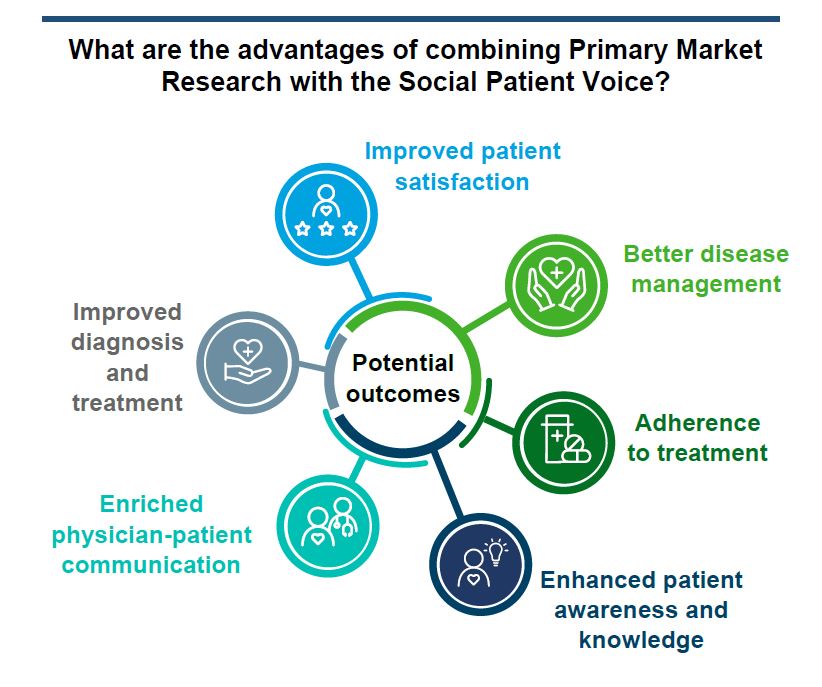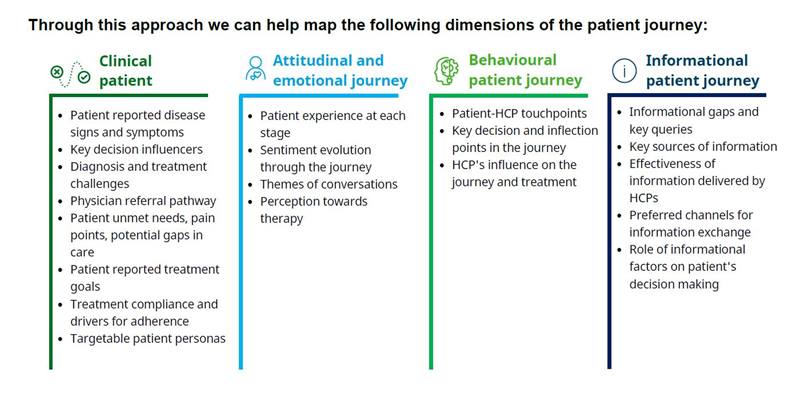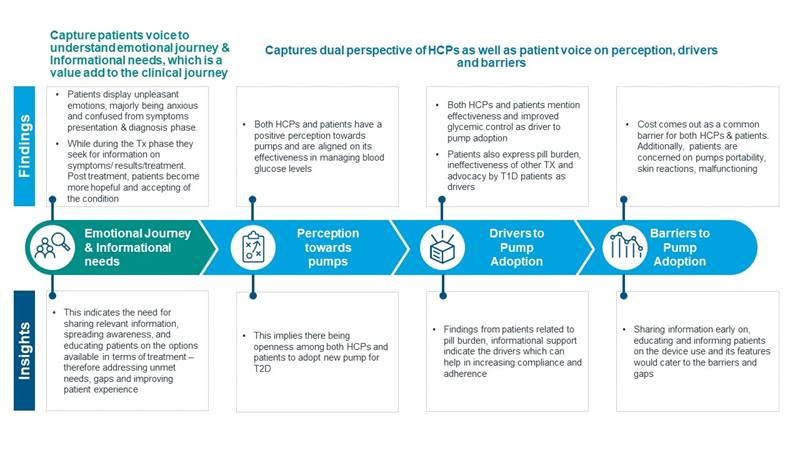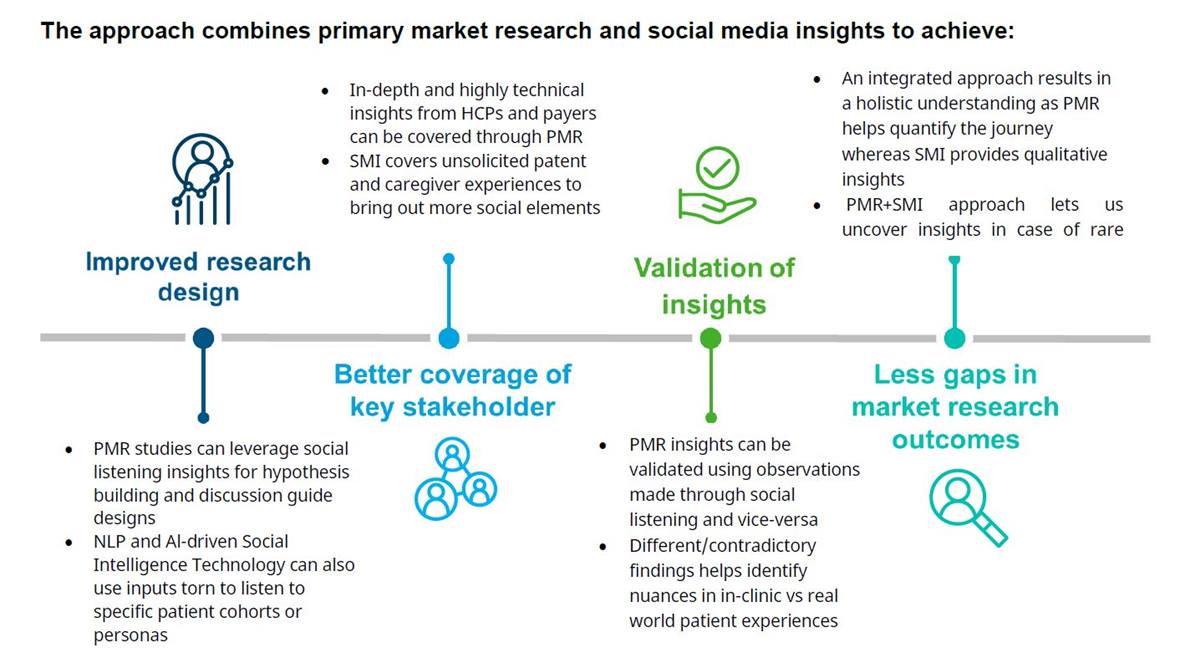Take advantage of the latest tools, techniques, and deep healthcare expertise to create scalable resources, precision insights, and actionable ideas.






















- Blogs
- Combining Patient Voice with Physician Insights to Improve Patient Experience and Deliver Better Healthcare Outcomes
The increasing digitization of healthcare and the exponential growth of social media has fundamentally changed the role of the patient in the treatment of their condition. The capacity to discuss their needs, fears and treatment protocols with likeminded patients globally has adapted how they perceive their role, from being a follower of traditional physician led decision making to a more empowered decision influencer of their own care. This paradigm shift requires a response from pharmaceutical and MedTech companies who have traditionally worked towards delivering the best patient outcomes by understanding the role and decision-making behaviors of physicians and engaging them to understand the patient journey. With a new active stakeholder now part of the treatment dialogue, the model for understanding patients journeys and making more effective decisions needs to be updated.
Patient Journey studies have become an increasingly valuable tool to enable decision making across the product lifecycle, to understand the person behind the patient, and inform brand strategy. In essence, the patient journeys provide a working model of patient /illness/treatment interactions, encompassing the full patient experience throughout their care pathway (onset of symptoms, consultation, treatment, and disease management) and the myriad interactions (both in-person and virtual) patients have with stakeholders through their treatment journey.
Traditionally, patient journey studies have been focused on the clinical, treatment protocol, and product-oriented aspects of healthcare. Under this model the personal patient experience was viewed largely through the lens of physicians, regulators, and payers, which neglected or downweighed the patient’s perspective in relation to their satisfaction, experience and engagement. This approach was therefore of more limited value in understanding and engaging with patients emotional and informational needs.

To date, Primary Market Research (PMR) has set the gold standard for understanding patient journeys, primarily through physician facing qualitative and quantitative studies to capture key patient journey insights from a clinical perspective. While these studies remain critically important to understand the motivations and decision-making process of the key physician/payer stakeholder group, they are more limited in generating insights for the emerging group of interconnected and empowered patients. To meet the needs of a new stakeholder, we need to evolve the patient journey model and give sufficient weight and value to their voice.
Understanding that the dynamics are changing, the IQVIA Social Media Intelligence (SMI) team has developed innovative data led techniques to capture, enrich, analyze and interpret patient level data and seamlessly incorporate it with physician and industry led patient journey studies to provide a holistic modern view of each stakeholder group to our clients.
IQVIA’s SMI team has been at the forefront of harnessing technology, Natural Language Processing (NLP) and human ingenuity to generate actionable insights from unstructured data on digital mediums. Our research indicates that patients and caregivers increasingly participate on social media networks to publicly share their disease treatment experiences, disease management challenges, emotional and social needs, and concerns around prognosis, diagnosis, and medication. Social Media has a become a rich source of uninhibited patient voice, offering access to previously unheard concerns, motivations, fears, desires and needs, at scale. We believe by understanding the person behind the patient our clients will be better positioned to identify, serve and engage the patient base and develop their business offering to benefit everyone. Our approach to patient journey has evolved and by integrating patient journey insights derived from physician PMR with those from our patient voice analysis model we are delivering a more comprehensive perspective than any other available to our clients.
The life sciences industry today focuses on mapping patient-centric journeys for precise targeting and personalized treatments. To achieve this the patient voice must be valued and captured for a deeper understanding of patient experiences, disease burdens, unmet needs, and inflection points across the journey. Such in-depth understanding can help companies devise effective patient-centric initiatives that drive better health outcomes.
IQVIA’s APPROACH TO CAPTURING IN-DEPTH INFORMATION ON ALL ASPECTS OF THE JOURNEY– CLINICAL, EMOTIONAL, BEHAVIORAL, AND INFORMATIONAL PATIENT INSIGHTS

Case Study: Patient and physician voice on T2D insulin pumps
The integrated approach above was deployed to map a holistic patient journey of Type 2 Diabetes (T2D) patients who have adopted or are considering an insulin pump.
We intended to capture the emotional journey with a dual perspective including the patient voice as well as the HCP’s opinion. Insights obtained from the research helped to guide and create strategies for patient engagement, mitigate barriers to pump adoption, and provide comparative user experience between brands.
The possibility of understanding patient journey through conventional methods was restricted due to the limited pool of T2D patients using pumps (treatment guidelines allow certified providers to prescribe pumps only to specific T2D diabetics based on a case-specific assessment). However, social media offered abundant feedback from patients who were proactively seeking this option but were often disqualified. Hence, this study called for an approach that combined insights derived from primary research combined with social media intelligence to achieve the project’s objectives.
There are two key benefits to leveraging social media insights in combination with PMR.
- Clear understanding of patients emotional and informational needs
- Dual perspective of physicians and patients regarding perception towards insulin pumps, drivers and barriers to pump adoption, etc.

Conclusion
Combining the insights generated from structured PMR with those from uninhibited patient conversations from social platforms provides an opportunity to develop a more comprehensive patient journey model and generate a deeper understanding of patient’s clinical and emotional needs along with practical challenges in managing the condition.
The insights from this approach can inform life sciences companies around core patient concerns and needs, key intervention potential along the care pathway and enable the devising of patient-centric strategies that improve patient access, experience and care. Companies embracing and incorporating patient voice into their strategies and solutions to establish a patient journey will benefit by:
- Informing go-to-market strategies for new product launches across geographies
- Developing relevant and effective patient support programs
- Identifying specific patient personas to design customized patient engagement solutions (includes marketing campaigns and patient specific informational materials)
- Improving HCP-patient communication for better patient experience and adherence
- Assisting to configure a comprehensive patient care team and devise strategies for effective physician involvement.
In short, such insights will inform more effective physician-centric and patient-centric communication and create a competitive advantage in the marketplace. More importantly, it will assist healthcare providers and patients achieve better healthcare outcomes.
Related solutions
Be proactive about growing your brand using the latest in data, analytics, and domain expertise.
Discover actionable brand insights at the intersection of market research and advanced analytics.
IQVIA Social Media Intelligence utilizes a blend of an AI-based patient intelligence platform and human ingenuity to conduct in-depth social listening and social media monitoring for the life sciences industry.






